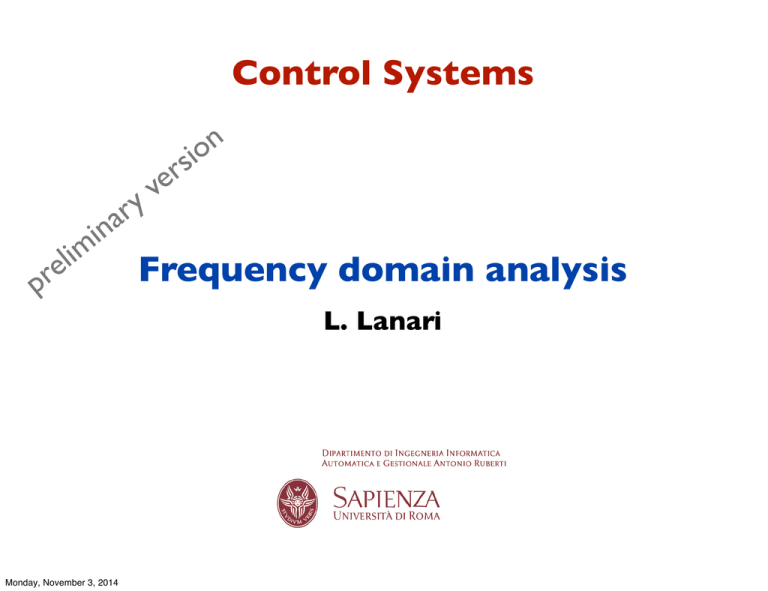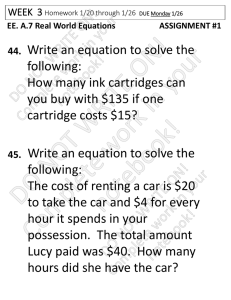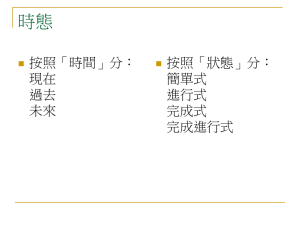Control Systems Frequency domain analysis
advertisement

Control Systems
m
i
l
e
r
p
r
a
in
r
e
v
y
n
is o
Frequency domain analysis
L. Lanari
Monday, November 3, 2014
outline
•
•
•
•
introduce the Laplace unilateral transform
define its properties
show its advantages in turning ODEs to algebraic equations
define an Input/Output representation of the system through
the transfer function
•
•
exploring the structure of the transfer function
solve a realization problem
Lanari: CS - Frequency domain analysis
Monday, November 3, 2014
2
Laplace transform
L
f (t)
F (s)
t∈R
complex valued function
in the complex variable
s∈C
F (s) =
for f with no impulse at t = 0
�
∞
0
f (t)e−st dt
Laplace (unilateral)
transform
F (s) = L[f (t)]
Region of convergence
Lanari: CS - Frequency domain analysis
Monday, November 3, 2014
3
Laplace transform
Laplace transform of the impulse
F (s) =
L[δ(t)] =
�
∞
�
∞
f (t)e−st dt
0−
δ(t)e−st dt =
0−
�
∞
δ(t)e−st dt = e−s0 = 1
−∞
Linearity
L[αf (t) + βg(t)] = αL[f (t)] + βL[g(t)]
Lanari: CS - Frequency domain analysis
Monday, November 3, 2014
4
Inverse Laplace transform
L
f (t)
F (s)
L−1
1
−1
f (t) = L [F (s)] =
2πj
�
α−j∞
F (s)est ds
α−j∞
f (t) defined for t ≥ 0
unique for one-sided functions
(one-to-one)
or f (t) = 0
Lanari: CS - Frequency domain analysis
Monday, November 3, 2014
for
t<0
5
Laplace transform
Derivative property
�
�
df (t)
= sL[f (t)] − f (0)
L
dt
can be applied iteratively
�
�
L f¨(t) = s2 L[f (t)] − sf (0) − f˙(0)
very useful in model derivation
Lanari: CS - Frequency domain analysis
Monday, November 3, 2014
6
LTI systems
also useful here
x(t)
˙
= Ax(t) + Bu(t)
(proof): linearity + derivative property
algebraic solution
X(s) = (sI − A)−1 x0 + (sI − A)−1 B U (s)
and therefore
Y (s) = C(sI − A)
−1
Lanari: CS - Frequency domain analysis
Monday, November 3, 2014
�
x0 + C(sI − A)
−1
�
B + D U (s)
7
LTI systems
state ZIR
transform
�
��
state ZSR
transform
�
�
��
�
X(s) = (sI − A)−1 x0 + (sI − A)−1 B U (s)
x(t) = eAt x0 +
�
t
eA(t−τ ) Bu(τ )dτ
0
and therefore, comparing
�
L e
�
L e
at
�
1
=
s−a
At
�
= (sI − A)−1
1
L [δ−1 (t)] =
s
Heaviside step function
δ−1 (t)
1 for t ≥ 0
0 for t < 0
1
t
Lanari: CS - Frequency domain analysis
Monday, November 3, 2014
8
LTI systems
y(t) = CeAt x0 +
=
=
Convolution theorem
L
0
w(t − τ )u(τ )dτ
W (s) = C(sI − A)−1 B + D
transform
��
t
w(t) = CeAt B + D δ(t)
with
Y (s)
�
C(sI − A)
�
x0 + C(sI − A)
C(sI − A)−1 x0 + W (s) U (s)
t
0
−1
−1
�
B + D U (s)
�
w(t − τ )u(τ )dτ = W (s) U (s)
being L[δ(t)] = 1 the output response transform corresponding to u(t) = ±(t) is indeed W(s)
same for H(s)
Lanari: CS - Frequency domain analysis
Monday, November 3, 2014
9
Transfer function
yZS (t) =
Input/Output behavior
x0 = 0
(ZSR)
�
t
0
w(t − τ )u(τ )dτ
YZS (s) = W (s) U (s)
Transfer function
W (s)
Input/Output behavior
=
C(sI − A)−1 B + D
=
YZS (s)
U (s)
=
L [w(t)]
independent from
state choice?
independent from state
space representation?
Lanari: CS - Frequency domain analysis
Monday, November 3, 2014
10
Transfer function
z = Tx
(A, B, C, D)
det(T ) �= 0
x˙
=
Ax + Bu
z˙
y
=
Cx + Du
y
� = T A T −1
A
�=TB
B
� B,
� C,
� D)
�
(A,
=
=
� = C T −1
C
� + Bu
�
Az
� + Du
�
Cz
� =D
D
�
� −1 B
�+D
�
W (s) = C(sI − A)−1 B + D = C(sI
− A)
For a given system, the transfer function is unique
Lanari: CS - Frequency domain analysis
Monday, November 3, 2014
11
Shape of the transfer function
W (s) = C(sI − A)−1 B + D
inverse through the adjoint (transpose of the cofactor matrix)
1
C (adjoint of (sI − A)) B + D
det(sI − A)
cofactor(i, j) = (−1)i+j minor(i, j) polynomial of order n - 1
polynomial of order n - 1
1
T
C (cofactor of (sI − A)) B + D
det(sI − A)
polynomial of order n
strictly proper rational function:
proper rational function:
Lanari: CS - Frequency domain analysis
Monday, November 3, 2014
rational function
(strictly proper)
degree of numerator < degree of denominator
degree of numerator = degree of denominator
12
Shape of the transfer function
W (s) = strictly proper rational function + D
proper rational function
N (s)
W (s) =
D(s)
N (s)
W (s) =
D(s)
D=0
strictly proper rational function
D �= 0
proper rational function
zeros
poles
roots
(for coprime N(s) & D(s))
i.e. no common roots
from previous analysis the poles are a subset of the eigenvalues of A
{poles}
Lanari: CS - Frequency domain analysis
Monday, November 3, 2014
⊆
{eigenvalues}
more on this later
13
Laplace transform (other properties)
Integral property
L
��
t
0
�
1
1
f (τ )dτ = L [f (t)] = F (s)
s
s
Time shifting property
L [f (t − T )δ−1 (t − T )] = e−sT L [f (t)δ−1 (t)] = e−sT F (s)
N(s) and D(s) are said to be coprime if they have no common factor
Lanari: CS - Frequency domain analysis
Monday, November 3, 2014
14
Laplace transform tables
δ(t)
1
δ−1 (t)
1
s
e
at
tk
k!
tk at
e
k!
1
s−a
1
sk+1
1
(s − a)k+1
sin ωt
1/2j
ω
1/2j
=
−
2
2
s +ω
s − jω s + jω
cos ωt
1/2
s
1/2
=
+
2
2
s +ω
s − jω s + jω
sin(ωt + ϕ)
s sin ϕ + ω cos ϕ
s2 + ω 2
eat sin ωt
ω
(s − a)2 + ω 2
at
e cos ωt
Lanari: CS - Frequency domain analysis
Monday, November 3, 2014
(s − a)
(s − a)2 + ω 2
15
Realizations
(A, B, C, D)
ok
W (s) = C(sI − A)−1 B + D
how ?
W (s) = C(sI − A)−1 B + D
•
•
•
•
realization
infinite solutions
(A, B, C, D)
state dimension ?
how can we easily find one state space representation (A, B, C, D) ?
may be complicated for MIMO systems (here SISO)
we see only one, obtainable directly from the coefficients of the transfer
function (others are obtainable by simple similarity transformations)
Lanari: CS - Frequency domain analysis
Monday, November 3, 2014
16
Realizations
N (s)
W (s) =
D(s)
coprime N(s) & D(s)
bn−1 sn−1 + bn−2 sn−2 + · · · + b1 s + b0
W (s) = n
+D
n−1
n−2
s + an−1 s
+ an−2 s
+ · · · + a1 s + a0
- find D
- state with dimension n
- one possible realization for A, B, C
Ac =
Cc =
�
0
0
···
0
−a0
b0
1
0
···
0
−a1
b1
b2
0
1
···
0
−a2
···
···
···
···
···
···
bn−1
Lanari: CS - Frequency domain analysis
Monday, November 3, 2014
0
0
···
1
−an−1
�
0
0
..
.
Bc =
0
1
Controller canonical form
(useful for eigenvalue assignment)
17







